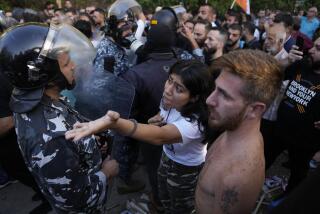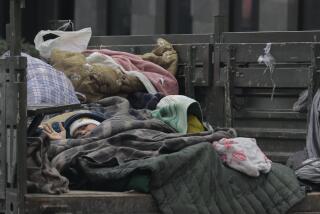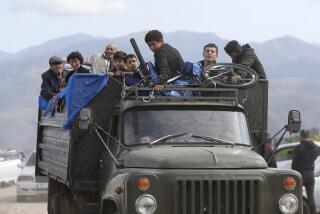Nationalists in Armenia Form New Movement
- Share via
YEREVAN, Soviet Union — Armenian opposition groups, which two years ago became the first nationalists to challenge the Communist Party openly in the Soviet Union, formed a new nationalist movement here Sunday with the aim of sweeping the forthcoming local elections and ousting the party from power.
Delegates to the Founding Congress of the Armenian All-National Movement adopted a constitution and program intended, as one speaker declared, to “enable the people to impose democracy on the party.”
Leaders of the new organization said they will attempt to translate into real political power the strongly nationalist appeals that regularly brought more than half a million people into the streets of Yerevan to demand the reunification with Armenia of Nagorno-Karabakh. The latter is a disputed enclave of Christian Armenians in Muslim Azerbaijan, a neighboring southern Soviet republic.
For many at the congress, the movement’s ultimate goal is independence for Armenia, but its political program left the question of succession to the future, preferring to focus first on fundamental political and economic changes within Soviet Armenia.
“The people living in Nagorno-Karabakh have decided that they cannot continue living as they have for the past 70 years, and today we have made the same decision for all Armenia,” said David Vardanyan, a member of the militant Karabakh Committee, which organized the mass protest.
“What we have done today is create a powerful, unified organization, one that is both broader and with greater depth in the community, to struggle for our national liberation. We expect it to give a big new impetus to that struggle.”
The organizers of the new movement, made up of 10 constituent groups, are attempting to develop the mass of support that the Karabakh Committee had in its rallies and general strikes into a national or popular front. Similar groups have been formed in the past year in other Soviet republics, where some now rival the Communist Party in influence.
The potential power of the Armenian All-National Movement was evident when Suren Arutunyan, first secretary of the Armenian Communist Party, addressed the opening session Saturday, pledging to work with the movement to achieve a program of national goals.
Describing Armenia as a common motherland and a common heritage, Arutunyan won wide support with an appeal that the party and government work together with the Armenian All-National Movement on their common goals.
And in a remarkable gesture of good will directed not only at the new organization but also to the Communist Party’s longtime opponents, Arutunyan called--to the cheers of the delegates--for a change in official attitudes toward the Tashnak Party. The Communists ousted this party from power in 1921 and have since castigated it as “anti-revolutionary, anti-Communist and anti-Soviet.”
Although its leaders and members have long been in exile, the Tashnak Party retains a following among many Armenians here as a truly nationalist alternative to Communist rule. Arutunyan’s conciliatory declaration appears to open the way for a new pluralism in Armenian politics, probably including a multi-party system in the future.
“This is a great event, a turning point in Armenian history,” Prof. Harkop Harkopian, a historian and political commentator, said. “This congress is one of the highest expressions of democracy we have had.
“The Karabakh movement has now become a national liberation movement for Armenia,” Harkopian said. “It is gathering all Armenians here in Soviet Armenia, in the internal Diaspora around the Soviet Union and in the external Diaspora abroad. . . . We are finally recognizing that we have so many problems that we cannot divide our forces as we have, that the goals are common for all of us.”
In terms of its program, the Armenian All-National Movement will seek to unite the often-fractious political and community groups within Armenia and among Armenians abroad to win the elections to be held Feb. 25 and establish what it calls a “true national government” in which the Communist Party would be just one component.
The program calls for far greater political and economic autonomy for Armenia, the negotiation of a new treaty between the central Soviet government and the republic on its authority, the drafting of a new Armenian constitution and the review of all federal laws as they apply in Armenia.
Other elements in the program include forming a market economy here, return of land to farmers, closure or transfer of industrial plants that threaten the environment, full freedom for the Armenian Apostolic Church and the restoration of old Armenian holidays and tradition in public life.
Many at the congress felt these goals fell far short of popular aspirations and urged that the new organization’s focus be on Armenian independence.
“We have no clear-cut idea of achieving independence in the nearest future,” a delegate from the embattled region of Nagorno-Karabakh said. “We should proceed step by step, but that should include the idea of independence. If we can clarify this, then there will be great unity, much strength and no division.”
But the rivalries that have divided Armenians for nearly a century were all evident on Sunday, as the delegates quarreled endlessly over the wording of the new movement’s constitution, its rules and its program.
Some of the disputes revolved around basic issues, including independence as a goal, but others focused on who would run the organization and what authority they would have.
“What you see is a kindergarten of politics,” one delegate observed, apologizing for the angry shouting in which the congress moved slowly forward. “For 70 years--those are the years of Soviet rule here--we have been deprived of the right to speak our minds and make our own decisions, and now politics proceeds as if it was almost a barroom brawl.”
More to Read
Sign up for Essential California
The most important California stories and recommendations in your inbox every morning.
You may occasionally receive promotional content from the Los Angeles Times.












